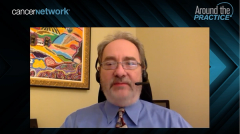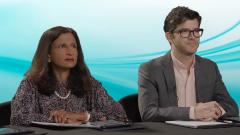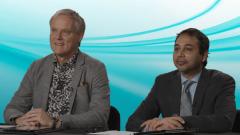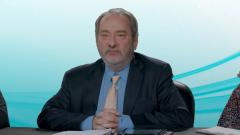
Role of Transplant and Induction Therapies in NDMM
Expert perspectives on the role of transplants and induction therapy in patients with newly diagnosed multiple myeloma (NDMM).
Episodes in this series

Transcript:
Robert Z. Orlowski, MD: Cesar, you get an important question: transplant, yes or no? You heard the data that Ola reviewed from the DETERMINATION study, where there was a PFS [progression-free survival] benefit but no OS [overall survival] benefit [regardless of whether] you got early transplant. What’s your take? Should everybody get a transplant? Should some people? Should nobody?
Cesar Rodriguez, MD: Transplant seems to be on the spot lately with all these novel therapies. Now that anti-CD3s are moving up front, is it still relevant to do a transplant? Even though transplant is a technique from the 1980s, it hasn’t changed much since then. It’s still proving its worth. The DETERMINATION and GRIFFIN studies are showing that it’s improving PFS and depth of response, even though it’s still not showing an overall survival. Part of the reason it’s not showing overall survival is that the studies are too early. We need to let them mature. We have so many salvage therapies, so if somebody relapses, we have another option for them.
Previously, we’d see overall survival changes in studies more easily because we didn’t have that many salvage treatment options. My take on how we manage myeloma is that our first punch should be our best punch. If we can get the best remission, the best control of the disease for the longest period of time, then that’s going to help us gain some time for the patient to recover the performance status and enjoy quality of life. At the same time, it gives us the opportunity to come up with new therapies that can potentially be safer or more effective at controlling the disease.
Robert Z. Orlowski, MD: This is an important question: transplant, yes or no? I want to open it up to other members of the panel. Ola, you’ve got your finger up.
C. Ola Landgren, MD: I agree with Cesar that we can’t throw out the baby with the bathwater. That’s important. Transplant is a valid treatment. Many patients benefit from it. But with more new options, life will always change. There will always be new things. That’s how everything is. New cell phones, new computers, new therapies—everything is moving forward. The DETERMINATION study did a good job. It captured quality of life as part of the protocol and showed that there was a significantly better quality of life in the nontransplant arm.
In 2023, our group published papers showing that with whole genome sequencing, after the exposure to melphalan, you gain 1000 to 2000 mutations in every cell in your body. Patients with myeloma have a higher risk for developing AML [acute myeloid leukemia] and MDS [myelodysplastic syndrome]. In the DETERMINATION study, there were 10 patients with AML or MDS with this shorter follow-up, and they were all in the transplant arm. What will happen when patients live 10 or 20 years? We don’t know, but patients are going to live longer with the newer drugs. This is an area where we have to pay attention. The long-term toxicity is not only transplant. It’s going to be all the immunotherapies also. Efficacy is 1 thing, but long-term toxicity is important for diseases like myeloma, where patients live for so long.
Amrita Krishnan, MD: Can I push back a bit? Those are valid points. To your point about the future, CAR [chimeric antigen receptor] T-cell therapy excites me. Cellular therapy and immunotherapy in myeloma are our future. Looking at that randomized compared with transplant—CAR T vs autologous transplant—as a consolidative strategy up front will be very interesting. Second, to your point about MDS, some of that has to do with understanding who the patient is going into transplant. In terms of clonal hematopoiesis risk factors predisposing for second malignancies, we haven’t done a good enough job of selecting patients—out or in—up front for that. That’s where the field is moving, to help determine that to further individualize the transplant decision.
Robert Z. Orlowski, MD: Ajay, how about you weigh in: transplant, yes or no?
Ajay K. Nooka, MD: I’ll comment on 1 thing that Ola stated about the health-related quality of life. Yes, there’s a dip in the transplant arm, but it was transient for 3 months. In the clinical practice, we see that dip in quality of life for 3 months, but they get back to normalcy at the end of 3 months. That’s a clarification. I still feel that transplant is the 1 that’s able to get us to the response that we’re anticipating…. We’re looking for MRD [minimal residual disease] negativity. What’s the best approach to reach that? Transplant. If that goal is what we’re looking for, and it has translated into a PFS benefit of more than 2 years, then I want to use that approach for my patients.
I also want to talk about the secondary primary malignancies. The devil lies in the details. Yes, there is an AML signal that you’re seeing: 10 vs 0, and 10 patients had AML. But if you look at the contrary, what is the best approach in the nontransplant arm? Seven of them had ALL [acute lymphocytic leukemia] in the nontransplant arm with 0 in the transplant arm. Could we say melphalan flufenamide is protective against ALL? We don’t know. As the field evolves, if you’re learning more, we’re amenable to the change. At this point, to gain that MRD negativity rate, I’m all in for the transplant.
Robert Z. Orlowski, MD: We’ll have to move on, but as a moderator, I’ll give you a moderate viewpoint. The way I practice is that if somebody has high-risk disease, I tend to transplant them no matter what level of response they have. But if they have good-risk disease molecularly and achieve MRD negativity, then they’re going to do well, I will typically give them the option of a harvest and hold. I don’t know whether that’s the right thing to do because we don’t have randomized data, but it’s 1 thing to consider.
C. Ola Landgren, MD: I do the same.
Robert Z. Orlowski, MD: Amrita, do you give 3 or 4 drugs to transplant-eligible patients? Maybe we can also do a quick poll of the panel on this.
Amrita Krishnan, MD: Four drugs.
Robert Z. Orlowski, MD: Cesar?
Cesar Rodriguez, MD: I’d go with 4 drugs too.
C. Ola Landgren, MD: Four drugs.
Ajay K. Nooka, MD: Four drugs.
Robert Z. Orlowski, MD: Four is unanimous. It sounds like we’d all do either daratumumab–VRd [bortezomib, lenalidomide, dexamethasone] or daratumumab–KRd [carfilzomib, lenalidomide, dexamethasone] and probably daratumumab plus CyBorD [cyclophosphamide, bortezomib, dexamethasone] for anybody with amyloidosis. For treatment duration, Ola, we’ll give you that question. A lot of these studies have a certain number of induction cycles and then you do transplant and then you do consolidation. But is there a right number for everybody or do you individualize and if so, based on what?
C. Ola Landgren, MD: There’s no right number, or at least we haven’t figured it out. There may be a secret number somewhere; we don’t know. We used to give 4 cycles of RVd [lenalidomide, bortezomib, dexamethasone], and that goes back to the good old days with an increase of vincristine, Adriamycin, and dexamethasone. If you gave more than that, you’d damage the heart of the patients. When that went away, the new therapy replaced the old, but the numbers remained the same. That’s the history of how that went.
Data emerged after that showing that there was money on the table. You could keep giving more cycles and deepen the response before you transplanted. Groups found that you could give 6 cycles of RVd [lenalidomide, bortezomib, dexamethasone]. We published a paper years ago that looked at 4, 5, 6, 7, and 8 cycles. We found that the yield for stem cell collection wasn’t different if you went even further. At different institutions I’ve worked at, we instituted 6 cycles as our default a long time ago, but different groups do different things.
Then we’d collect and check for MRD. When we used KRd [carfilzomib, lenalidomide, dexamethasone] or daratumumab–KRd [carfilzomib, lenalidomide, dexamethasone], we had very high rates of MRD negativity. After we collect the stem cells, we’d typically give 2 more cycles. That would give us a total of 8. That number is out of the blue, but a lot of studies have used 8, so we have too. After this, we put patients on maintenance.
There’s also the question of doing 2-drug maintenance. If we look at the GRIFFIN study, that has 2 years of daratumumab-lenalidomide, and then patients continue with lenalidomide. Other studies that have continued to use a 2-drug combination. There are also trials that have a single drug. They’re also coming in bispecifics in combination with lenalidomide or only bispecifics. I’m not sure what I’m going to do in the long term, but I use daratumumab with lenalidomide and give daratumumab once a month for 1 year. I repeat the bone marrow to confirm MRD negativity and then go forward with lenalidomide maintenance. But I may change that in the future. I do that because I want to limit immunosuppression and the development of hypogammaglobulinemia. What do you do?
Amrita Krishnan, MD: I like the FORTE results in terms of high-risk disease. I’ve used daratumumab-based induction, but I use carfilzomib-lenalidomide for my maintenance strategy because the high-risk numbers for 17p and 1q gain are promising. That reserves the daratumumab for later if I need it, or I put on the SWOG study though as my first choice.
Robert Z. Orlowski, MD: For the home audience, FORTE is the study looking at the second randomization where you did the lenalidomide vs the carfilzomib-lenalidomide, and the carfilzomib-lenalidomide did better. Any last thoughts about transplant-eligible patients?
Cesar Rodriguez, MD: I see transplant as an investment. That’s what I tell patients. A lot of the time, when the patient is sitting with us and we’re talking about the option of consolidating their response with a transplant, some say, “I feel so good. Why am I going to go through a transplant and maybe feel bad for a period of time?” The quality of life for the 3 months after the transplant might be a bit worse for somebody who doesn’t get a transplant. But I tell them to look at this as an investment because you’re going to get a benefit down the road: longer control of your disease. You won’t have to be on dexamethasone for a longer period of time, which is something that patients complain about. That’s my takeaway in terms of transplant. I see it as an investment for the future.
Robert Z. Orlowski, MD: An investment with dividends, but sometimes patients aren’t interested in that investment.
Cesar Rodriguez, MD: That’s up to them. They have the option to choose.
Robert Z. Orlowski, MD: Fair enough.
Transcript edited for clarity.
Newsletter
Stay up to date on recent advances in the multidisciplinary approach to cancer.























































































